

Original Article - Year 2006 - Volume 21 -
Trabalho Premiado - Prêmio Silvio Zanini 2005: Estudo da Relação da Pressão Liquórica do Canal Raquimedular e Intracraniana em Pacientes Portadores de Craniossinostose
The study of the relationship of the liquored pressure of the spinal canal and intra cranial in patients caring craniosynostosis*
RESUMO
Há aproximadamente 10 anos, desenvolvemos nosso trabalho clínico e cirúrgico no Hospital da Sobrapar, temos tido a oportunidade de acompanhar um grande número de pacientes portadores de craniossinostose, doença altamente complexa, que necessita de acompanhamento multidisciplinar com um pessoal altamente qualificado. Denomina-se craniossinostose o conjunto de anomalias que apresentam ossificação prematura das suturas dos ossos do crânio e da face. Este distúrbio pode ocorrer de forma parcial ou completa, como pode também comprometer uma ou mais suturas. O grau de comprometimento e as suturas envolvidas manifestam-se nas mais variadas formas clínicas, podendo comprimir o cérebro, impedindo seu crescimento, o que denominamos de cranioestenose, ocasionando efeitos deletérios sobre o sistema nervoso central. Estas formas, às vezes bizarras, que o crânio assume já eram há muito conhecidas, tendo sido descritas por Hipócrates na antiguidade. O objetivo deste estudo é avaliar a correlação entre a pressão do líquor no interior do canal raquimedular e a pressão do crânio, no pré-operatório imediato à craniectomia descompressiva. Haja vista as dificuldades técnicas e controvérsias encontradas na literatura, com relação à indicação cirúrgica para descompressão do encéfalo, e havendo a possibilidade de se saber o valor da pressão intracraniana com uma simples punção lombar, através da medida direta da pressão dentro do canal raquimedular, tal fato facilitaria na indicação do procedimento cirúrgico. Foram operados 10 pacientes com cranioestenose, sendo registradas medidas da pressão liquórica por punção lombar e por trepanação do crânio, momentos antes de se proceder à craniectomia descompressiva. Após análise estatística dos resultados, observamos haver correlação significativa entre as pressões do líquor no canal raquimedular e intracraniana nos pacientes com cranioestenose, possibilitando-nos diagnosticar e quantificar a pressão intracraniana, sem a necessidade de uma trepanação no crânio.
Palavras-chave: Craniossinostose, complicações. Pressão intracraniana
ABSTRACT
For about ten years, we have developed our surgical operation and clinic job at Sobrapar Hospital and we have had the opportunity of follow a great number of "Cranium-synostoses" holder patients, this pathology has high complexity, and needs multidiscipline following by a highly qualified personal group. "Cranium-synostoses" is the name of the anomalies that show up premature ossification of cranio bones suture and of the face. This disturb can occur in a complete or partial way, as can implicate one or more sutures. The degree of the implication and the suture involved show up itself in the most diverse clinic forms, it can compress the brain, obstructing its growing for this we named "Cranium-synostoses", occasioning deleterious effects upon the Central nervous system. Those forms, sometimes bizarre, that the cranium change was known many years ago, it was described in the antiquity by Hipocrates.The aim of this study is to evaluate the correlations between the liquor pressure into the internal spinal medullary duct, and the cranium, in the immediate moment before of surgery for reduction compress craniectomy. As seen, the technical difficulties and controversies found in the specific literature related to surgical indication to uncompress the encephalon and there being possibility of knowing the size of intracranial pressure with a simple lumbar puncture with the direct measurement of pressure inside the internal spinal medullary duct, this make easy the indication of the surgical proceeding. There were operated ten patients with "Cranium-stenosis", and there being under register the liquor pressure by lumbar puncture and for cranium trepaning moments before of the procedure a reduction compress craniectomy. After statistics analysis results, we observed there is significant correlation between the liquor pressure into the internal spinal medullary duct and intracranial, in the patients with "Craniumstenosis", this enable us to quantify and to diagnose the intracranial pressure without the cranium trepanning. However, the surgery of reduction compress craniectomy show up it self decreasing expressively the levels of liquor pressure into the both chambers in the right after post-operative.
Keywords: Craniosynostoses, complications. Intracranial pressure
Liquido Cerebrospinal
Toda a cavidade que envolve o cérebro e a medula possui um volume aproximado de 1.650 ml, no adulto, sendo que cerca de 150 ml deste volume são ocupados por liquor. Este fluido é encontrado nos ventrículos cerebrais, nas cisternas ao redor do cérebro e no espaço subaracnóide, que circunda tanto o cérebro como a medula. Todas estas cavidades estão mutuamente interligadas e a pressão do liquor é regulada em um nível constante.
Pressão Liquórica
A pressão normal no sistema liquórico varia com a idade, no adulto, em posição de decúbito dorsal horizontal, alcança a média de 10 mmHg (130 mm de água), sendo um limite tolerável (borderline) de 15 mmHg, acima disto é considerado hipertensão intracraniana1-6.
Os valores normais da pressão intracraniana apresentam variações nos pacientes mais jovens, sendo normal um valor aproximado de 2 mmHg nos neonatos, 5 mmHg até os 12 meses e de 6 a 13 mmHg nos maiores de 7 anos7.
A cavidade cerebrospinhal intradural é indistensível em seu compartimento craniano, por encontrar-se a dura-máter aderida à tábua interna do osso, mas apresenta algum grau de distensibilidade no compartimento espinhal. Este fenômeno deve-se à capacidade de enchimento do saco dural espinhal, às custas da compressão do coxim gorduroso peridural espinhal, permitindo variações de volume graças ao deslocamento do sangue do plexo venoso epidural espinhal, uma vez que considera-se a dura-máter praticamente indistensível8-10.
Admite-se também que algum grau de elasticidade do parênquima nervoso também contribua para a compensação volumétrica intracraniana11.
As variações do volume sangüíneo cerebral e do volume compartimental do L.C.R são, portanto, os principais fatores responsáveis pela capacidade de compensação volumétrica intracraniana9,12.
As mudanças do volume sangüíneo cerebral respondem por até 66% desta capacidade de compensação e os deslocamentos do L.C.R são os responsáveis pelos restantes 33%.
Classificação Morfológica das Craniossinostoses
De forma didática, podemos classificar em dois grupos os pacientes portadores de craniossinostoses: sindrômicos e nãosindrômicos.
Sinais e Sintomas do Paciente com Cranioestenose
A fusão prematura das suturas do crânio ocasiona a cranioestenose, está geralmente associada ao aumento da pressão intracraniana, seja por restrição do crescimento do encéfalo ou pela dificuldade no retorno venoso pela base do crânio que se encontra deformada, ou ainda devido a associações com outras alterações que aumentem ou dificultem a reabsorção do liquor. Constata-se que este aumento da pressão intracraniana torna-se extremamente maléfico ao desenvolvimento neuropsicomotor da criança.
A hipertensão intracraniana pode acometer qualquer tipo de craniossinostose, seja ela simples, complexa, sindrômica ou não. A cefaléia, a queda da acuidade visual geralmente devido à atrofia do nervo óptico, as ceratites freqüentes, causadas pela exposição da córnea nos casos de exoftalmia acentuada e outras alterações oftalmológicas, como o estrabismo, estão presentes na maioria destes pacientes.
Diagnóstico
Geralmente, o perímetro cefálico não compatível com a idade costuma ser o primeiro sinal ao exame físico, porém este pode estar normal. O diâmetro do crânio também pode estar normal em um sentido, mas aumentado em outro, sendo que uma inspeção cuidadosa do crânio pode indicar quais suturas estão acometidas.
Nos exames radiológicos, a radiografia simples de crânio nas posições de perfil e ântero-posterior, poderá nos mostrar a presença das suturas ou a soldadura das mesmas, sendo que o afilamento da díploe óssea e a erosão dos processos crinóides posteriores associados ao "sinal" do cobre batido são indicativos, porém não comprobatórios, de que haja hipertensão intracraniana. Nas tomografias computadorizadas de crânio, podemos analisar o tamanho dos ventrículos, a espessura da tábua óssea, a presença de hidrocefalia e o estreitamento dos sulcos anterior e posterior. Com relação à ressonância nuclear magnética, é precoce dizer o quanto esse exame poderá acrescentar em relação às craniossinostoses, visto que não há grande experiência relatada na literatura.
Como podemos observar, alguns sintomas e sinais radiológicos indiretos são utilizados na indicação do tratamento cirúrgico1, porém, na literatura, observamos uma dificuldade em se estabelecer critérios técnicos para a indicação do tratamento cirúrgico, portanto questiona-se o seguinte: operar ou não; quando operar; qual é a idade mais apropriada, com menor risco cirúrgico1.
Assim sendo, a pressão intracraniana passou a ser mais investigada por pesquisadores, com o objetivo de determinar quais os valores da pressão intracraniana que poderiam ser sugestivos à indicação cirúrgica, para se evitar o comprometimento cerebral, devido à hipertensão.
Como o liquor nos espaços cerebrais e no canal raquidiano está em comunicação, objetivamos encontrar um método, que embora invasivo, seja mais prático e menos agressivo que a trepanação direta do crânio para a medida da pressão intracraniana.
Portanto, é o objetivo do presente trabalho avaliar a correlação existente entre os valores da pressão intracraniana e do liquor no canal raquimedular, no pré-operatório dos pacientes portadores de cranioestenose que serão submetidos à cirurgia descompressiva.
Métodos de Monitorização da Pressão Intracraniana
Atualmente, temos disponíveis, para a medida da pressão intracraniana, aparelhos de transmissão da pressão, através de coluna líquida ("fluid-coupled") ou fibra óptica, com captores de pressão instalados nos ventrículos laterais, no parênquima cerebral, no espaço subaracnóide ou epidural e no canal raquimedular1,10.
Os cateteres subaracnóides apresentam, como principais vantagens, a maior facilidade na implantação, levando a um menor risco de lesões de parênquima, menor risco de infecções associadas, estimadas em 0 a 14,9% e um custo menor. As desvantagens incluem as dificuldades na manutenção da monitorização, principalmente em níveis elevados e na manipulação do paciente, necessitando de freqüentes irrigações para obter-se a qualidade da monitorização10 (Figura 1).
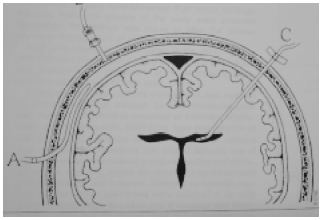
Figura 1 - Esquema ilustrativo do posicionamento dos cateteres. A - Subdural. B - Extradural. C - Ventricular (adaptado de Aucoin et al.13).
HISTÓRICO
A craniossinostose designa a fusão prematura de uma ou mais suturas da abóbada craniana ou da base do crânio.
Hipócrates forneceu a primeira descrição dessa anomalia em 400 a.C. Ele notou a variável aparência das deformidades do calvário e as correlacionou ao modelo de envolvimento das suturas cranianas14. Coube a Lanne Lougue, em 1892, a realização da primeira craniotomia linear para tratamento de craniossinostose15.
Com o advento de novas técnicas de neurocirurgia, Faber e Towne publicaram, em 1927, excelentes resultados e recomendaram o tratamento cirúrgico precoce, devido ao aumento da pressão intracraniana.
OBJETIVOS
Este trabalho tem como objetivos:
MÉTODO
Foram selecionados 10 pacientes portadores de craniossinostose, tanto sindrômicas, como as não-sindrômicas; de ambos os sexos, na faixa etária entre 1 e 14 anos, os quais apresentavam-se para tratamento destas deformidades no Hospital da Sobrapar, de acordo com a sua entrada no serviço. Foram considerados sintomas como: cefaléia, irritabilidade e os sinais radiológicos sugestivos de hipertensão intracraniana, como o sinal do "cobre batido" observados nas telerradiografias cefalométricas e a diminuição dos ventrículos e do espaço subdural observados nas tomografias computadorizadas de crânio, como fatores indicativos para a cirurgia.
Nestas condições, os pacientes foram submetidos à cirurgia para implantação dos cateteres e realização do procedimento cirúrgico, o qual consiste basicamente em uma craniectomia descompressiva, adaptando-se a técnica cirúrgica empregada ao quadro clínico apresentado.
Este procedimento cirúrgico segue a seguinte padronização técnica:
1. Anestesia geral com intubação orotraqueal, sendo que todos os pacientes foram submetidos à anestesia geral venosa e inalatória sob sistema fechado com reabsorção de CO2, observando-se a utilização de anestésicos que não interfiram na pressão intracraniana;
2. Punção lombar no espaço entre a 3a e 4a vértebra lombar com agulha G 27 (Conjunto para anestesia espinhal contínua - Spinocath, agulha G 27, cateter G 22 intra-dural - B. Braw), com introdução através da agulha, do cateter utilizado para anestesias peridurais contínuas, retirada a agulha e fixado o cateter, onde foi conectado ao sistema de medição próprio do monitor para registros da pressão liquórica (Monitor de sinais vitais modelo 1100 - 4 Criticare Systems, Inc. - USA);
3. Incisão da pele, subcutâneo, gálea e periósteo, no sentido coronal; iniciando-se junto ao pavilhão auricular direito, estendendo-se até o pavilhão auricular esquerdo, no lado direito e a 6 cm do início da incisão é feita uma trepanação com broca infantil (5 mm), adaptada ao trépano, com bloqueio automático (3M do Brasil Ltda);
4. Abertura da dura-máter e introdução de cateter de aspiração traqueal nº8 (Sondaplast Ltda,SP), no espaço subdural, direcionando-o à região frontal, com introdução de aproximadamente 6 cm;
5. Acoplada a sonda ao sistema de medição próprio do monitor de sinais vitais, onde já estava acoplado o cateter situado no canal raquimedular;
6. Após a calibração do aparelho, realizamos a primeira leitura da pressão do liquor no canal raquimedular (P.C.R) e, simultaneamente, a pressão intracraniana;
7. Finalizada a craniectomia, os cateteres são mantidos no pós-operatório imediato para melhor controle na unidade de terapia intensiva.
As primeiras medidas tomadas e registradas foram durante o ato cirúrgico com o paciente deitado, com a cabeça apoiada diretamente sobre o colchão e o aparelho calibrado com a pressão atmosférica local, utilizando-se o conduto auditivo externo como referência.
As medidas pressóricas utilizadas neste trabalho foram:
Foram considerados normais os níveis de pressão intracraniana até 10 mmHg, "borderline" níveis até 15 mmHg e níveis acima de 20 mmHg foram considerados como hipertensão intracraniana, sendo instituído tratamento específico pela equipe de pediatras.
Os valores dos níveis de pressão considerados normais para o crânio também o foram para o canal raquidiano1-6.
O material utilizado para captação dos níveis de pressão no interior do canal raquimedular e do crânio é mostrado nas Figuras 2 e 3.
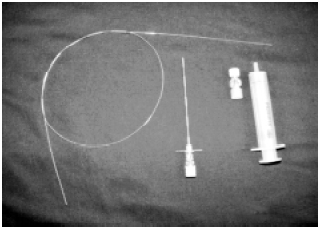
Figura 2 - Conjunto para anestesia espinhal contínua (Spinocath).
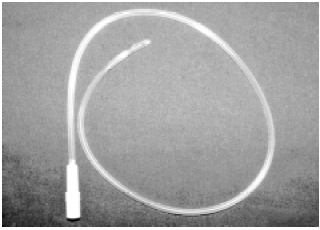
Figura 3 - Cateter para aspiração traqueal Nº 8.
O ponto de referência (conduto auditivo externo) e os pontos de projeção da coluna lombar são mostrados na Figura 4.
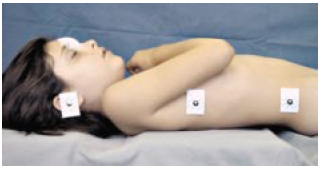
Figura 4 - Pontos de referência utilizados no estudo - conduto auditivo externo e de projeção da coluna lombar.
RESULTADOS
Foram analisados, prospectivamente, 10 pacientes portadores de craniossinostose, apresentando sintomatologia clínica e sinais radiológicos de cranioestenose. Houve predomínio do sexo masculino, sendo seis (60%) pacientes.
Deste total de 10 pacientes, cinco (50%) eram portadores de craniossinostose não-sindrômica e os outros cinco (50%) de craniossinostose sindrômica.
A média de idade foi de 5,8 anos (dp = 3,3), com uma mediana de seis anos, variando de 1 a 11 anos.
A caracterização dos pacientes desta casuística, com suas respectivas idades, sexo e diagnósticos, foi a seguinte (Tabela 1).
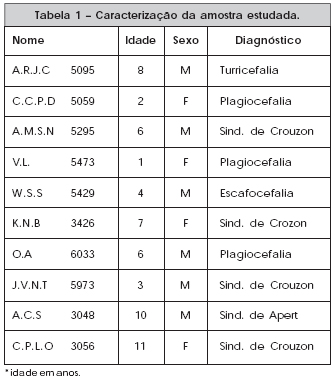
Os valores das medidas pressóricas estão relacionados na Tabela 2.

Os resultados da correlação entre as pressões do canal raquidiano e da pressão intracraniana estão apresentados na Figura 5.
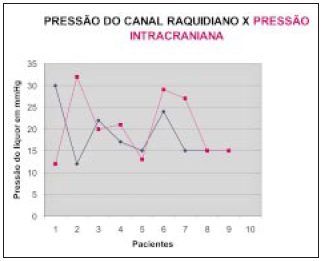
Figura 5 - Resultados da correlação entre as pressões do canal raquidiano e intracraniana (p < 0,02).
Por problemas técnicos no registro das pressões do paciente A.C.S 3048, optamos por não utilizar seus registros no cálculo estatístico, portanto o estudo foi realizado com nove pacientes.
Análise Estatística
Analisando-se as medidas da pressão liquórica do canal raquidiano (P.C.R), e a pressão intracraniana (P.I.C); registradas antes da craniectomia descompressiva dos nove pacientes e utilizando-se o método estatístico de análise de regressão simples, encontramos a regressão polinomial do terceiro grau, na qual houve uma correlação significativa com um coeficiente de correlação de r = 0.7878, confirmada após aplicação do método do t de Student, obtendo-se o seguinte resultado: t = 3,3845 (7 graus de liberdade), p < 0,02.
A regressão polinomial do terceiro grau tem um coeficiente de correlação: r = 0.7878 e o desvio de regressão: s = 5.7525. Polinômio de 3º grau y= a + bx + cx^2 + dx^3 (Figura 6). Coeficientes: a = 321.47739; b = - 46.638879; c = 2.3132103; d = - 0.036743093.
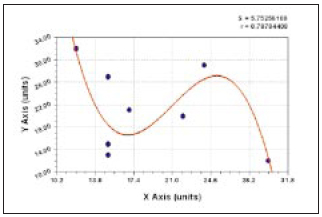
Figura 6 - Regressão polinomial de 3º grau.
DISCUSSÃO
Apesar do pequeno número de pacientes avaliados neste estudo, conseguimos padronizar um método de monitoração da pressão intracraniana e da pressão do canal raquimedular, com baixo custo e fácil manuseio, possibilitando o estudo da correlação existente entre as duas tomadas de pressão.
O método empregado para a seleção dos pacientes deverá ser melhor avaliado e aprimorado, pois a variabilidade com que a craniossinostose apresenta-se é muito grande.
O aparelho utilizado nas medidas das pressões foi prático e confiável; sendo possível sua calibração a qualquer momento necessário.
Os cateteres utilizados, tanto no canal raquimedular, como no crânio, além de custo operacional baixo; foram de fácil manipulação e não causaram qualquer reação adversa ao organismo.
A partir dos dados desta casuística, acreditamos que a punção lombar seja uma opção para o diagnóstico da hipertensão intracraniana, sendo este um método que, apesar de invasivo, deva ser avaliado como alternativa.
CONCLUSÕES
Com base na análise desta casuística, pode-se concluir que:
1. O método subdural para a medida da P.I.C, utilizando-se um cateter de plástico, mostrou-se bastante aplicável, sendo considerado seguro, simples e de baixo custo;
2. A utilização do conjunto para anestesia espinhal contínua para a medida da pressão do canal raquimedular foi de fácil manuseio, ótima flexibilidade, apresentando utilidade considerável na medida da pressão, pois foi de fácil adaptação aos conectores do aparelho.
3. O valor da pressão do liquor no canal raquimedular pode ser usado para a obtenção do valor da pressão intracraniana.
REFERÊNCIAS BIBLIOGRÁFICAS
1. De Rougemont J. La pression intra-cranienne. Neurochirurgie. 1974;20(6):473-88.
2. Guyton AC. Tratado de fisiologia médica. 6a ed. Rio de Janeiro: Interamericana;1984. 926p.
3. Gonsalez S, Hayward R, Jones B, Lane R. Upper airway obstruction and raised intracranial pressure in children with craniosynostosis. Eur Respir J. 1997;10(2):367-75.
4. Thompson DN, Malcolm GP, Jones BM, Harkness WJ, Hayward RD. Intracranial pressure in single-suture craniosynostosis. Pediatr Neurosurg. 1995;22(5):235-40.
5. Siddiqi SN, Posnick JC, Buncic R, Humphreys RP, Hoffman HJ, Drake JM et al. The detection and management of intracranial hypertension after initial suture release and decompression for craniofacial dysostosis syndromes. Neurosurgery. 1995;36(4):703-9.
6. Tuite GF, Chong WK, Evanson J, Narita A, Taylor D, Harkness WF et al. The effectiveness of papilledema as an indicator of raised intracranial pressure in children with craniosynostosis. Neurosurgery. 1996;38(2):272-8.
7. Fok H, Jones BM, Gault DG, Andar U, Hayward R. Relationship between intracranial pressure and intracranial volume in craniosynostosis. Br J Plast Surg. 1992;45(5):394-7.
8. Langfitt TW. Increase intracranial pressure. Clin Neurosurg. 1969;16:436-71.
9. Novais V. Hérnias cerebrais internas. In: Siqueira MG, ed. Atualização em neurocirurgia: tumores intracranianos. Porto Alegre:Missau;1982. p.73-124.
10. Wilkinson HA. Intracranial pressure. In: Youmans JR, ed. Neurological surgery: a comprehensive reference guide to the diagnosis and management of neurosurgical problems. 3a ed. Philadelphia Saunders;1990. p.661-95.
11. Sklar FH, Elashvili I. The pressure-volume function of brain elasticity. Physiological considerations and clinical applications. J Neurosurg. 1977;47(5):670-9.
12. Colli BO. Hipertensão intracraniana: fisiopatologia, diagnóstico e tratamento. J Bras Neurocir.1990;2(1):25-34.
13. Aucoin PJ, Kotilainen HR, Gantz NM, Davidson R, Kellogg P, Stone B. Intracranial pressure monitors. Epidemiologic study of risk factors and infections. Am J Med. 1986;80(3):369-76.
14. Weinzweig J, Salomon J. Craniossinostose. In: Weinzweig J, ed. Segredos em cirurgia plástica. Philadelphia: Hanley & Belfus;1998. p.141-50.
15. Marchac D, Renier D. Chirurgie cranio-faciale des craniosténoses. Paris:Médecine et Sciences Internationales; 1982. 173p.
SOBRAPAR - Serviço do Prof. Dr. Cássio M. Raposo do Amaral. UNICAMP- Universidade Estadual de Campinas, Campinas, SP.
Trabalho realizado no Hospital SOBRAPAR e Unicamp
Artigo recebido: 10/10/2005
Artigo aprovado: 14/11/2005
* Orientador: Prof. Dr. Cássio Menezes Raposo do Amaral (in memorian)
Colaborador: Prof. Dr. Alberto Magna


 Read in Portuguese
Read in Portuguese
 Read in English
Read in English
 PDF PT
PDF PT
 Print
Print
 Send this article by email
Send this article by email
 How to Cite
How to Cite
 Mendeley
Mendeley
 Pocket
Pocket
 Twitter
Twitter